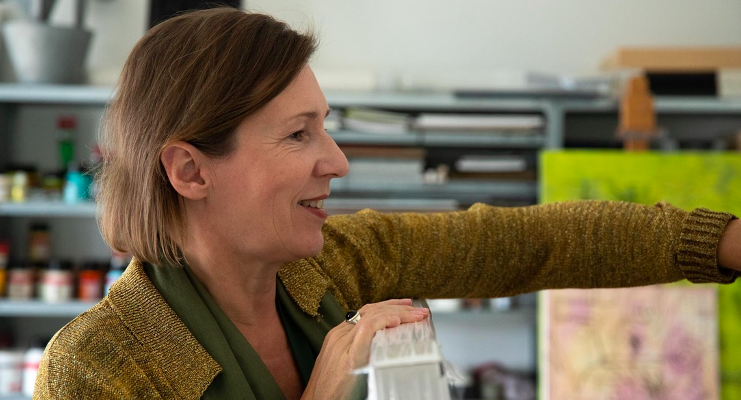“I am happy when I work…”
Paul Zimmerman in conversation with Pamela Maria
Paul Zimmerman: You use a wide range of materials. How do you select your medium?
Pamela Maria: The choice of mediums is a natural process while working. In my work I investigate the relationship between landscape and abstraction. The beauty of the Dutch landscape has been an inspiration for many artists before me. The dunes, the sea, the polders, the famous Dutch light are, for me too, a rich source for identity, geography and tradition. Present, past and future are intertwined in this. And with my art I question these themes and the way I see, interpret and visualize the landscape and my position in it.
Each work is a story about where I belong. Whether it is rooted in the reality or in the imagination. This ‘interweaving of aspects’ manifests itself in ‘layered images’ and a ‘mixture of materials’: nothing is what it seems to be. The various mediums are a way to direct the eye, to emphasize the complexity and to create a layered abstraction. A method to interweave the themes.
PZ: When do you come up with the idea of titles?
PM: With the idea for a series or a subject (for example: reflections, moving colors, vertical city, plane trees, shades of white), the title is usually given. Some works derive their title from a specific location or a mood.
PZ: What is the most challenging aspect of your work?
PM: The search for a balance between the abstract and realism. And then only 24 hours in a day and a lot of inspiration/ideas to explore.
PZ: What is your artistic process? How do you create your paintings?
PM: Working is inspiration. And experimenting with colors, shapes, wiring etc. is an essential part of the process. I work on several paintings at the same time. Each in a different stage of the process. While looking at one I can finish the other for example. I work every day. Luckily my atelier is next to my house: being able to start and end the day in the atelier, even for a quick look, is essential for me. It’s on the 8th floor and I have a wonderful view over the neighborhood, the centre of Amsterdam and perhaps most important, the sky. A continuous changing painting itself. While walking, I take photos of details which catch my eye: colors, structures, the skin of objects, people; there is so much beauty in everyday life. Those images slide over each other in my head and form the base for new paintings. My works take time to create and time to decipher.
PZ: How do you know when the painting is finished?
PM: The making of a painting is to visualize my inner world of imagination. It is similar to composing I think like the composer hears the music, the musical notes and instruments in his head, I see the color, the texture, the image in my head, it is still diffuse but stroke after stroke, wire after wire it is getting out of the fog, clearer and clearer until it is sharp and the image is fixed. The painting needs to have a secret, a story in it. Which becomes more interesting the longer you look at it. Perhaps even more beautiful.

PZ: Have your practice changed over time?
PM: Due to circumstances like an economic crisis, the responsibility for two children to raise, I had a meandering professional practice over the past 20 years. Since a few years I can fully focus on my work as an artist again. I am very grateful for that, and my goal is to create amazing works and reach out to the world.
PM: I am proud that recently in Rome I have been awarded the ‘Women’s Art Award 2020’ by the UNESCO in collaboration with Musa International Art Space. An important side effect for me is the expansion of my international network in the art world: in 2021 my work will be on show in the Far East (Singapore), USA (New York City) and in Austria and Belgium. For 2022 I am invited to attend an exhibition in Venice during the Art Biennale. Another big change over the years is the development of the online art market and the social media: it has become part of my day-to-day business.
PZ: How would you describe yourself as an artist?
PM: I am happy when I work, when I am able to visualize my place in life.
PZ: Which artists influenced you?
PM: There are many, I think. I listen a lot to the music of J.S. Bach. I appreciate artists like the Dutch ‘zero’ artist Jan Schoonhoven because of his focus at ‘nonmaterial’ and monochrome works. David Hockney because of his love for nature and daily life. Edgar Fernhout because of his urge to ‘become sea or winter to be able to paint it’. And many female artists because of their endurance in a male art world.
PZ: What is art?
PM: Art is an ‘object’ in which you see (a part of) yourself reflected. You can drown in it. It sucks you in, to the undercurrents, to everything that resides below the surface and vibrates and sparkles.
PZ: How does the pandemic influence your work and sensibility?
PM: I am used to work alone, being on my own. The lack of exposure this year is, in moments, difficult. Luckily the online sales increased. The lack of distraction makes me more sensitive to the inner world but also invites to reflect, experiment and develop work for a new era. I sense an increasing need to unbundle instead of the desire to interweave themes, which might lead to more realistic work in the future…
